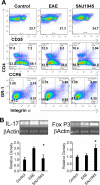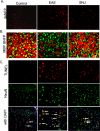Effects of a novel orally administered calpain inhibitor SNJ-1945 on immunomodulation and neurodegeneration in a murine model of multiple sclerosis
- PMID: 24447070
- PMCID: PMC4107076
- DOI: 10.1111/jnc.12659
Effects of a novel orally administered calpain inhibitor SNJ-1945 on immunomodulation and neurodegeneration in a murine model of multiple sclerosis
Abstract
Multiple sclerosis (MS) pathology is marked by the massive infiltration of myelin-specific T cells into the CNS. Hallmarks of T helper (Th) cells during active disease are pro-inflammatory Th1/Th17 cells that predominate over immunoregulatory Th2/Treg cells. Neurodegeneration, a major factor in progressive MS, is often overlooked when considering drug prescription. Here, we show that oral dosing with SNJ-1945, a novel water-soluble calpain inhibitor, reduces experimental autoimmune encephalomyelitis clinical scores in vivo and has a two pronged effect via anti-inflammation and protection against neurodegeneration. We also show that SNJ-1945 treatment down-regulates Th1/Th17 inflammatory responses, and promotes regulatory T cells (Tregs) and myeloid-derived suppressor cells in vivo, which are known to have the capacity to suppress helper as well as cytotoxic T cell functions. Through analysis of spinal cord samples, we show a reduction in calpain expression, decreased infiltration of inflammatory cells, and signs of inhibition of neurodegeneration. We also show a marked reduction in neuronal cell death in spinal cord (SC) sections. These results suggest that calpain inhibition attenuates experimental autoimmune encephalomyelitis pathology by reducing both inflammation and neurodegeneration, and could be used in clinical settings to augment the efficacy of standard immunomodulatory agents used to treat MS. Multiple sclerosis (MS) pathology is marked by inflammation and infiltration of myelin-specific T cells into the central nervous system. Inflammation leads to neurodegeneration in progressive MS which also leads to epitope spreading, feedback looping to more inflammation. Calpain can play a role in both arms of the disease. Here, oral dosing with SNJ-1945, a novel water-soluble calpain inhibitor, reduces experimental autoimmune encephalomyelitis clinical scores in vivo and has a two-pronged effect via anti-inflammation and protection against neurodegeneration.
Keywords: EAE; calpain; inflammation; multiple sclerosis.
© 2014 International Society for Neurochemistry.
Figures






Comment in
-
Targeting calpain-mediated proteolysis and peptide signaling as a strategy to reduce injury in multiple sclerosis.J Neurochem. 2014 Jul;130(2):161-4. doi: 10.1111/jnc.12732. Epub 2014 May 21. J Neurochem. 2014. PMID: 24844646 No abstract available.
Similar articles
-
Targeting calpain-mediated proteolysis and peptide signaling as a strategy to reduce injury in multiple sclerosis.J Neurochem. 2014 Jul;130(2):161-4. doi: 10.1111/jnc.12732. Epub 2014 May 21. J Neurochem. 2014. PMID: 24844646 No abstract available.
-
Calpain inhibition reduces structural and functional impairment of retinal ganglion cells in experimental optic neuritis.J Neurochem. 2016 Oct;139(2):270-284. doi: 10.1111/jnc.13770. Epub 2016 Sep 27. J Neurochem. 2016. PMID: 27513991 Free PMC article.
-
Calpeptin attenuated inflammation, cell death, and axonal damage in animal model of multiple sclerosis.J Neurosci Res. 2010 Aug 15;88(11):2398-408. doi: 10.1002/jnr.22408. J Neurosci Res. 2010. PMID: 20623621 Free PMC article.
-
Immunomodulation neuroprotection and remyelination - the fundamental therapeutic effects of glatiramer acetate: a critical review.J Autoimmun. 2014 Nov;54:81-92. doi: 10.1016/j.jaut.2014.05.005. Epub 2014 Jun 14. J Autoimmun. 2014. PMID: 24934599 Review.
-
Role of Th17 cells in the pathogenesis of CNS inflammatory demyelination.J Neurol Sci. 2013 Oct 15;333(1-2):76-87. doi: 10.1016/j.jns.2013.03.002. Epub 2013 Apr 8. J Neurol Sci. 2013. PMID: 23578791 Free PMC article. Review.
Cited by
-
Neuron-microglia interaction induced bi-directional cytotoxicity associated with calpain activation.J Neurochem. 2016 Nov;139(3):440-455. doi: 10.1111/jnc.13774. Epub 2016 Oct 18. J Neurochem. 2016. PMID: 27529445 Free PMC article.
-
CAPN5 genetic inactivation phenotype supports therapeutic inhibition trials.Hum Mutat. 2019 Dec;40(12):2377-2392. doi: 10.1002/humu.23894. Epub 2019 Aug 26. Hum Mutat. 2019. PMID: 31403230 Free PMC article.
-
Neuroprotection mediated by inhibition of calpain during acute viral encephalitis.Sci Rep. 2016 Jun 27;6:28699. doi: 10.1038/srep28699. Sci Rep. 2016. PMID: 27345730 Free PMC article.
-
Protective Effects of Calpain Inhibition on Neurovascular Unit Injury through Downregulating Nuclear Factor-κB-related Inflammation during Traumatic Brain Injury in Mice.Chin Med J (Engl). 2017 Jan 20;130(2):187-198. doi: 10.4103/0366-6999.198001. Chin Med J (Engl). 2017. PMID: 28091411 Free PMC article.
-
Calpain activation and progression of inflammatory cycles in Parkinson's disease.Front Biosci (Landmark Ed). 2022 Jan 13;27(1):20. doi: 10.31083/j.fbl2701020. Front Biosci (Landmark Ed). 2022. PMID: 35090325 Free PMC article. Review.
References
-
- Banik NL, Chakrabarti AK, Hogan EL. Distribution of calcium activated neutral proteinase (mM CANP) in myelin and cytosolic fractions in bovine brain white matter. Life Sci. 1987;41:1089–1095. - PubMed
-
- Banik NL, Matzelle DC, Gantt-Wilford G, Osborne A, Hogan EL. Increased calpain content and progressive degradation of neurofilament protein in spinal cord injury. Brain research. 1997;752:301–306. - PubMed
-
- Berlet HH. Calcium-dependent neutral protease activity of myelin from bovine spinal cord: evidence for soluble cleavage products of myelin proteins. Neurosci Lett. 1987;73:266–270. - PubMed
-
- Bjartmar C, Trapp BD. Axonal and neuronal degeneration in multiple sclerosis: mechanisms and functional consequences. Current opinion in neurology. 2001;14:271–278. - PubMed
Publication types
MeSH terms
Substances
Grants and funding
LinkOut - more resources
Full Text Sources
Other Literature Sources
Medical

